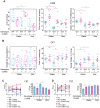Fto Deficiency Reduces Anxiety- and Depression-Like Behaviors in Mice via Alterations in Gut Microbiota
- PMID: 30809304
- PMCID: PMC6376469
- DOI: 10.7150/thno.31562
Fto Deficiency Reduces Anxiety- and Depression-Like Behaviors in Mice via Alterations in Gut Microbiota
Abstract
Depression and obesity have high concurrence within individuals, which may be explained by sharing the same risk factors, including disruption of the intestinal microbiota. However, evidence that delineated the causal connections is extremely scarce. Methods: Mice lacking fat mass- and obesity-associated gene (Fto) were generated. Fto-deficient and wild-type control mice were subjected to novel conditions with or without chronic unpredictable mild stress (CUMS) for 6 weeks. Some mice were treated with antibiotics via their drinking water for 6 weeks in order to deplete their microbiota. Behavioral tests were performed to evaluate anxiety- and depression-like behaviors. 16S rRNA amplicon and metagenomic sequencing were employed to analyse fecal microbiota. Plasma levels of inflammatory cytokines and lipopolysaccharides (LPS) were also compared. Results: Deletion of Fto led to lower body weight and decreased anxiety- and depression-like behaviors, Fto+/- mice were also less susceptible to stress stimulation, highlighting the essential role of Fto in pathogenesis of depression. With regard to gut microbiota, Fto deficiency mice harbored specific bacterial signature of suppressing inflammation, characterized with higher abundance of Lactobacillus, lower Porphyromonadaceae and Helicobacter. Critically, behavioral alterations of Fto+/- mice are mediated by shift in gut microbiota, as such changes can be partially attenuated using antibiotics. Exposure to CUMS increased serum IL-6 level while Fto deficiency reduced its level, which may be explained by a lower LPS concentration. Conclusion: Together, our findings uncover the roles of Fto on depression and provide insights into microbiota-related biological mechanisms underlying the association between obesity and depression.
Keywords: Fto; Depression; Lactobacillus; Microbiota; Obesity.
Conflict of interest statement
Competing Interests: The authors have declared that no competing interest exists.
Figures







References
-
- Guilbert JJ. The world health report 2002 - reducing risks, promoting healthy life. Educ Health (Abingdon) 2003;16:230. - PubMed
-
- Milaneschi Y, Simmons WK, van Rossum E, Penninx BW. Depression and obesity: evidence of shared biological mechanisms. Mol Psychiatry; 2018. doi: 10.1038/s41380-018-0017-5. [Epub ahead of print] - PubMed
-
- Zhang Y, Ji G, Li G, Ghrelin reductions following bariatric surgery were associated with decreased resting state activity in the hippocampus. Int J Obes (Lond); 2018. doi: 10.1038/s41366-018-0126-x. [Epub ahead of print] - PubMed
Publication types
MeSH terms
Substances
LinkOut - more resources
Full Text Sources
Medical
Molecular Biology Databases

